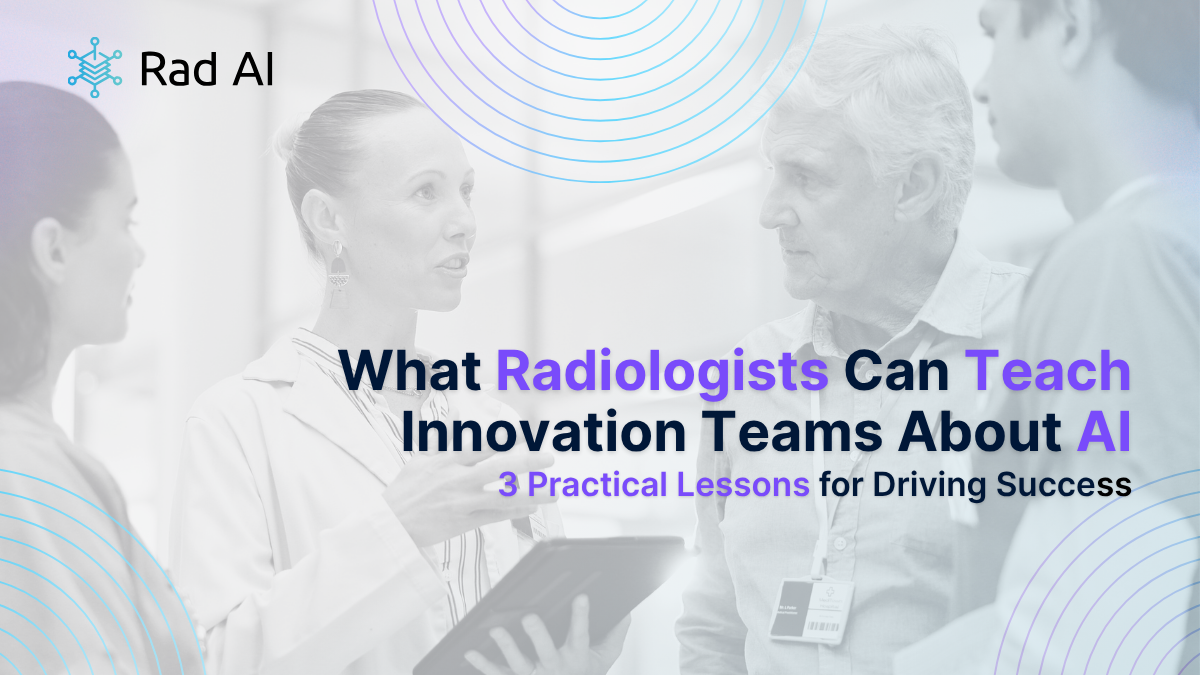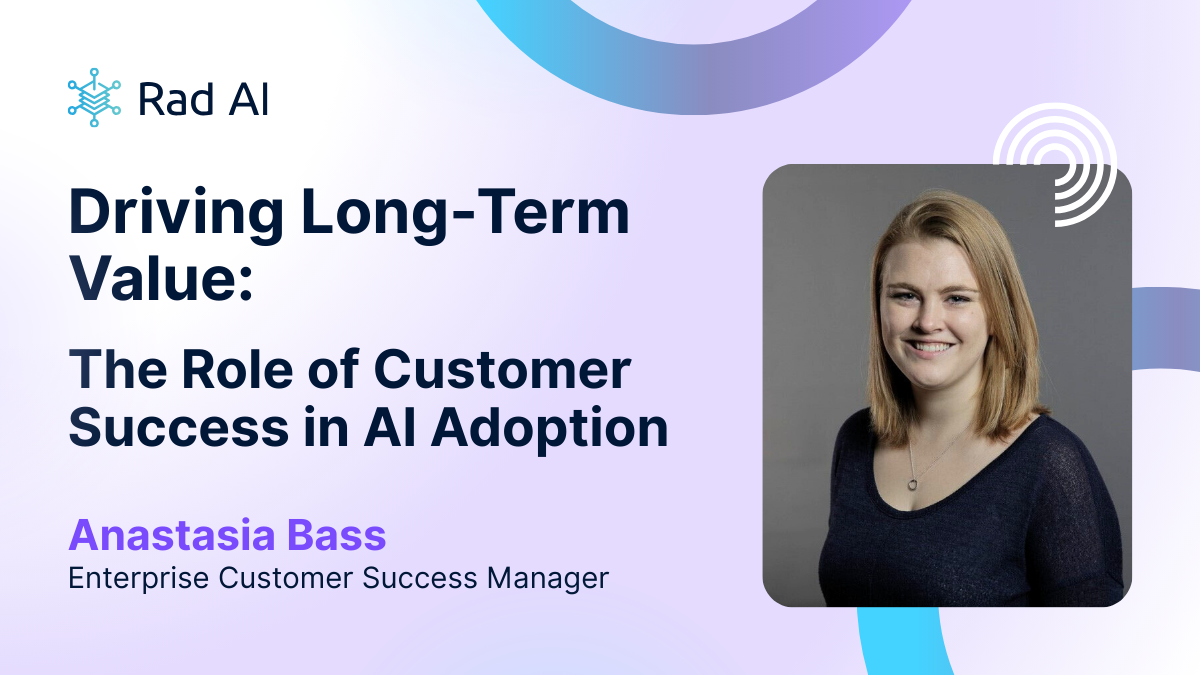Beyond the AI Hype: What Radiologists Can Teach Healthcare Innovation Teams About AI That Actually Works


3 Practical Lessons for Driving Success
The healthcare industry is facing a dual challenge: navigating an explosion of new artificial intelligence (AI) tools while battling a widespread epidemic of physician burnout. Innovation teams are under intense pressure to implement technology that genuinely solves problems, not just adds complexity.
Healthcare Innovation teams must look to radiologists, who have long pioneered the use of advanced technology, to find a reliable blueprint for high-impact AI implementation.
A recent Mass General Brigham (MGB)-led study on AI-driven ambient documentation technologies gives us that essential roadmap. By demonstrating that AI can significantly reduce physician burnout, the research provides three non-negotiable lessons for every innovation team seeking to move beyond the hype and discover AI solutions that deliver measurable value.
The success of the MGB ambient documentation study is not a coincidence; it is a direct result of applying the rigorous, workflow-first methodology, which has long been mastered in radiology, to other high-burnout areas of hospitals and health systems.
Lesson 1: Target the Administrative Burden that Drives Burnout
Radiologists are masters of efficiency. They utilize technology to automate repetitive tasks, allowing them to focus on complex diagnostics. MGB’s ambient documentation study validates this strategy by focusing AI on the largest non-clinical time-consuming tasks: EHR documentation and efficient reporting workflows.
Physician burnout is notoriously linked to the hours spent documenting after the clinic closes. By eliminating this administrative burden, the study saw a stunning 21% reduction in burnout prevalence at Mass General Brigham (Mass General Brigham, 2025).
The Takeaway: The highest ROI for innovation isn't always about marginal gains in throughput; it’s about strategically eliminating the non-core work that forces your high-value talent to sacrifice personal time. Use AI to deliver professional relief.
Lesson 2: The Ultimate Metric Isn’t Efficiency; It’s Restored Joy
Any new tool can claim to speed up a process, but true innovation enhances the entire practice of medicine. For a radiologist, technology is successful when it eliminates workflow friction and supports their core expertise, enabling them to focus fully on the diagnostic challenge. The MGB study achieved a similar outcome across specialties, not by aiding diagnosis but by eliminating a source of chronic, draining frustration.
The results go beyond metrics. Physicians reported that AI liberated them from their keyboards, giving them their "nights and weekends back" and allowing them to "rediscover their joy of practicing medicine" (Mass General Brigham, 2025).
The Takeaway: Your innovation strategy must include a Human-Centric UX Goal. Solutions that directly improve a clinician's quality of life and restore professional fulfillment achieve enthusiastic, system-wide adoption.
Lesson 3: Use Rigorous Data to Validate Value and Defeat the Hype
Radiologists demand clear, undeniable data and clinical validity before adopting new solutions or processes. Innovation teams must apply this same rigor to their AI adoption strategy. You need evidence that the chosen solution works in the chaotic, real-world setting of a health system.
Effective innovation requires quantitative proof. Programs that consistently succeed demonstrate this by measuring their human impact. For instance, the fact that researchers point specifically to physician burnout data (the quantifiable drop in burnout prevalence) speaks volumes about the promise of these types of technologies, proving the value of the strategic shift (Mass General Brigham, 2025).
The Takeaway: To transition a solution from a pilot project to system-wide implementation, you must validate the AI using hard data on human impact, including metrics such as burnout reduction, time spent on non-clinical tasks, time spent outside of working hours, and physician retention rates. That is the only way to prove an innovation is transformative.
Stop Chasing the Hype, Start Driving Value
The future of healthcare AI isn't about chasing the latest shiny object. It’s about strategically deploying proven technology to solve genuine, pressing human problems. Radiologists’ deep experience, built on decades of validating and scaling complex AI and digital systems under high-volume demand, provides a starting framework for high-impact technology adoption.
For Innovation leaders, these lessons translate into more timely, criteria-driven evaluation and prioritization. For Operations and IT, they mean fewer surprises and cleaner integration paths. For Clinical leaders, they deliver measurable relief and restored joy in their practice, not just increased throughput.
The question now is: how do you turn these lessons into action? How do you move from pilots and good intentions to repeatable frameworks with clear decision points and real clinical impact?
Now, it's time to translate these lessons into a repeatable framework with clear decision points and implementation guardrails each stakeholder can use to move from pilot to sustained operation and clinical impact.
Turn Shared Intent into Shared Execution
That’s exactly what we’ll cover in our upcoming webinar, Beyond the Hype: What Healthcare Really Needs from AI. You’ll hear how healthcare groups are aligning across Clinical, Innovation, IT, and Operations to operationalize these practices — and you’ll leave with standardized decision points, integration checkpoints, and expansion thresholds your teams can rally around.
Reference
Mass General Brigham. (2025, August 21). Ambient Documentation Technologies Reduce Physician Burnout and Restore 'Joy' in Medicine. Retrieved from https://www.massgeneralbrigham.org/en/about/newsroom/press-releases/ambient-documentation-technologies-reduce-physician-burnout





